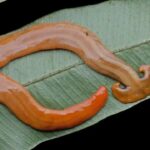They’re long and skinny. They’re boomerang-headed and coated in toxic mucus. And they’ve been hiding in plain sight in the US for a long time.
Invasive hammerhead flatworms have distinctive curved heads, striped bodies ranging in color from light yellow to dark brown, and they can secrete tetrodotoxin — a neurotoxin found in puffer fish and blue-ringed octopuses.
Some species are no more than an inch (2.5 centimeters) long, but others measure up to 15 inches (38 centimeters) in length. If you chop them into bits, each part will regenerate into a complete worm.
The worms are known across the southeastern US, and with recent hammerhead sightings in Washington, DC, New Yorkers and others in the Northeast Corridor may be wondering how long it will be before the toxic invaders inch their way farther north.
The worms are already right at home in New York state (and likely more of the country than we suspect) and have been around for decades, said Peter Ducey, a professor of biological sciences at the State University of New York at Cortland.
“These animals are widespread in New York,” Ducey told CNN. “They’re widespread and abundant.”
The worms originated in Southeast Asia and are thought to have arrived in the US in 1891 in landscaping material, according to the US Department of Agriculture’s National Invasive Species Information Center.
Because the worms tend to end up wherever the soil is transported, “they’re in a lot of gardens and yards and around houses,” he said. “Within those habitats, they’re in leaf litter. You often find them under rocks or logs or pieces of trash.”
“When handling flatworms, gloves should be worn or the hands washed after,” according to a fact sheet from the college. “The risk from prolonged exposure to chemicals in land planaria mucus is likely low but unknown, so caution should be used regardless.”
Read More Here: Meet — but don’t touch — the toxic invasive worm that experts say has been hiding in plain sight
Glancy News – News at a Glance




